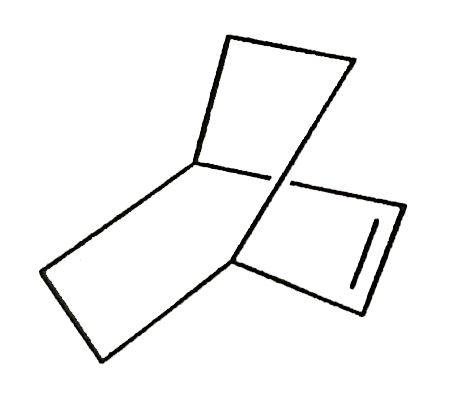The following sequence of reactions is used to convert borax into boron (B).
Na2[B4O5(OH)4]Borax.8H2Ox−−→H3BO3Δ−−→B2O3Y−−→BBoron
Reagents X and Y are respectively
Acid, Al
Base, C
Base, Fe
Acid, Mg
The correct Answer is:D
To convert borax (Na₂B₄O₅(OH)₄·8H₂O) into boron (B), we need to identify the reagents X and Y in the sequence of reactions provided. Here’s the step-by-step breakdown of the reactions involved:
Step 1: Conversion of Borax to Boric Acid
1. Starting Material: Borax (Na₂B₄O₅(OH)₄·8H₂O).
2. Reagent X: To convert borax into boric acid (H₃BO₃), we need an acid. Common acids used for this purpose include hydrochloric acid (HCl) or sulfuric acid (H₂SO₄).
3. Reaction:
Na2B4O5(OH)4⋅8H2O+HCl (or H2SO4)→H3BO3+NaCl (or Na2SO4)+H2O
4. Conclusion: Thus, reagent X is an acid (HCl or H₂SO₄).
Step 2: Heating Boric Acid to Form Boron Trioxide
1. Next Step: The boric acid obtained from the previous reaction is then heated.
2. Reaction:
H3BO3Δ−→B2O3+H2O
3. Conclusion: Heating boric acid results in the formation of boron trioxide (B₂O₃).
Step 3: Conversion of Boron Trioxide to Boron
1. Reagent Y: To convert boron trioxide (B₂O₃) into boron (B), we need a reducing agent. Common reducing agents include magnesium (Mg) or sodium (Na).
2. Reaction:
B2O3+3Mg→2B+3MgO
or
B2O3+6Na→2B+3Na2O
3. Conclusion: Thus, reagent Y can be either magnesium or sodium.
Final Answer
- Reagent X: Acid (HCl or H₂SO₄)
- Reagent Y: Magnesium (Mg) or Sodium (Na)
Summary of Options
- Based on the options provided, the correct reagents are:
- Reagent X: Acid
- Reagent Y: Magnesium (Mg)
1. Starting Material: Borax (Na₂B₄O₅(OH)₄·8H₂O).
2. Reagent X: To convert borax into boric acid (H₃BO₃), we need an acid. Common acids used for this purpose include hydrochloric acid (HCl) or sulfuric acid (H₂SO₄).
3. Reaction:
Na2B4O5(OH)4⋅8H2O+HCl (or H2SO4)→H3BO3+NaCl (or Na2SO4)+H2O
4. Conclusion: Thus, reagent X is an acid (HCl or H₂SO₄).
1. Next Step: The boric acid obtained from the previous reaction is then heated.
2. Reaction:
H3BO3Δ−→B2O3+H2O
3. Conclusion: Heating boric acid results in the formation of boron trioxide (B₂O₃).
1. Reagent Y: To convert boron trioxide (B₂O₃) into boron (B), we need a reducing agent. Common reducing agents include magnesium (Mg) or sodium (Na).
2. Reaction:
B2O3+3Mg→2B+3MgO
or
B2O3+6Na→2B+3Na2O
3. Conclusion: Thus, reagent Y can be either magnesium or sodium.
- Reagent X: Acid (HCl or H₂SO₄)
- Reagent Y: Magnesium (Mg) or Sodium (Na)
- Based on the options provided, the correct reagents are:
- Reagent X: Acid
- Reagent Y: Magnesium (Mg)
Topper's Solved these Questions
- THE P-BLOCK ELEMENTSBOOK - AAKASH INSTITUTE ENGLISHCHAPTER - THE P-BLOCK ELEMENTSEXERCISE - Assignment Section-C)
23 Videos
- THE P-BLOCK ELEMENTSBOOK - AAKASH INSTITUTE ENGLISHCHAPTER - THE P-BLOCK ELEMENTSEXERCISE - Assignment Section-D)
15 Videos
- THE P-BLOCK ELEMENTSBOOK - AAKASH INSTITUTE ENGLISHCHAPTER - THE P-BLOCK ELEMENTSEXERCISE - Assignment Section-A)
94 Videos
- THE D AND F-BLOCK ELEMENTS BOOK - AAKASH INSTITUTE ENGLISHCHAPTER - THE D AND F-BLOCK ELEMENTS EXERCISE - Assingment ( Section-J Aakash Challengers Questions )
10 Videos
- THE S-BLOCK ELEMENTSBOOK - AAKASH INSTITUTE ENGLISHCHAPTER - THE S-BLOCK ELEMENTSEXERCISE - Assignment (Section-J)
10 Videos
Similar Questions
Knowledge Check
Consider the following sequence of reactions
AC3H6Cl2alc.KOH−−−−−→ΔBB2H6−−−−−−→H2O2/ΘOHC,Aalc.KOH−−−−−→ΔC The compound A is :A B
B C
C D
D
Na2B4O7.10H2OΔ−−→XΔ−−→Y+Z,XY and Z in the reaction are
AX=Na2B4O7,YNaBO2,Z=B2O3BX=Na2B4O7,Y=B2O3,Z=H3BO3CX=B2O3,Y=NaBO2,Z=B(OH)3DX=NaBO2,Y=B2O3,Z=B(OH)3CH3−CH∣Br−CH2−O∣∣C−CH3N2HO(4),ϴOH−−−−−−−−−−−→Δ Product:
A B
B C
C D
D
CH3CH2COONH4P2O5−−→ΔXH+/H2O−−−−−→Y.
Y and X respectively are
View SolutionBorax is converted into crystalline boron by the following steps :
Borexx−−→H2BO3Δ−−→B2O3Y−−→ΔB
X and Y are respectively :
View SolutionRCH=CH2(1)O3−−−−−−−−−−−−→(2)H2O\(Zn)(A)H2O−−−−−−→LiAIH4(B)
Product (B) is
View Solution (i)O3−−−−−−−−→(ii)Zn−H2O¯:OH−−→Δ NO. of aldol condensation product.
(i)O3−−−−−−−−→(ii)Zn−H2O¯:OH−−→Δ NO. of aldol condensation product.
View SolutionPh−CH2−CH2CH3∣⊕N∣CH2CH2CH3−CH3ΘOH−−→Δ
View Solution
